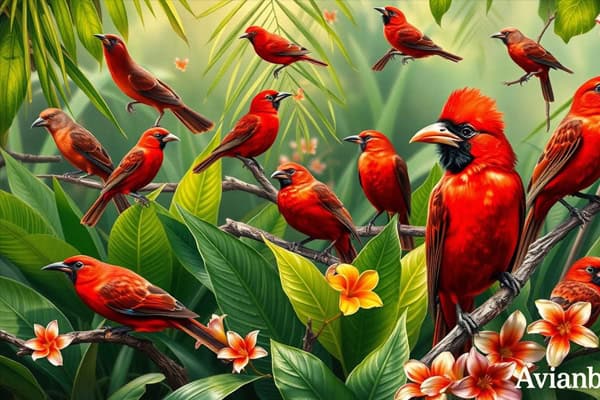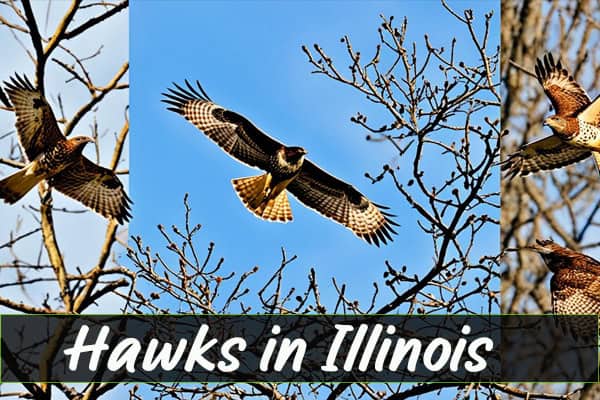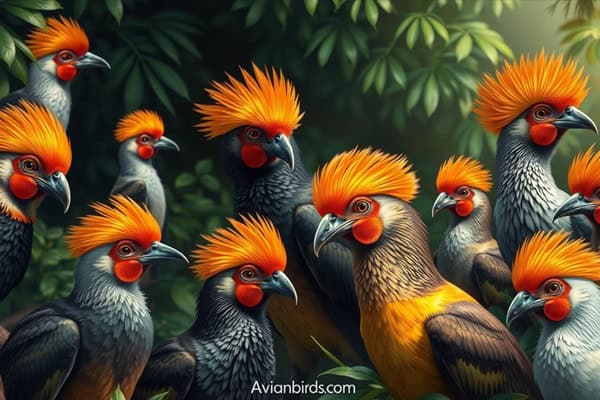9 Types of Ducks in Hawaii (ID Guide With Pictures)
Ducks in Hawaii, Did you know there are only about 2,000 Hawaiian Ducks left on Kauai? They are among the rarest waterbirds in the world. As you explore Hawaii’s beautiful islands, you’ll find many different ducks, each one displaying the rich variety of these lush landscapes.
From the endangered Hawaiian Ducks to migratory visitors, Hawaii’s duck story is one of survival and adaptation. You’ll learn about the native Anas wyvilliana. This species symbolizes the fight for conservation in a changing world. Let’s explore these amazing waterbirds and their important role in Hawaii’s ecosystem.
Introduction to Ducks in Hawaii
Ducks are key to Hawaii’s bird life and help keep the ecosystems balanced. Many duck species are found nowhere else, demonstrating the islands’ natural beauty.
These Hawaiian ducks, like the Koloa Maoli, face big challenges. Habitat loss and mixing with other ducks are major problems.
The number of Hawaiian ducks has changed a lot over time. Today, there are about 2,200 birds in Kauai and Hawaii. But it’s hard to know how many are pure Hawaiian ducks and how many are mixed.
Learning about the history of duck decline is important. It helps us understand why we need to save these birds.
In the next parts, you’ll learn more about Hawaiian ducks. You’ll see their special traits, where they live, and why we must protect them for the future.
Understanding Hawaiian Ducks
Learning about Hawaiian ducks reveals their special traits and where they live. The Koloa Maoli, a native duck, has brown feathers that help it hide. It likes mountain streams and wetlands, showing that it can live in many places in Hawaii.
Characteristics and Habitat
Hawaiian ducks are different from others. Males are bigger than females, with males being 48–50 cm long and females 40–43 cm; this size difference is an important aspect of avian sex determination. They eat plants, mollusks, and tiny animals in water. They lay about eight eggs at a time, often in hidden spots.
These ducks need wetlands to survive, where they find food. In places like Kauai, efforts keep them safe from other ducks. This helps keep their special traits alive.
Importance of Wetlands to Duck Populations
Wetlands are key for Hawaiian ducks. They help ducks find food and places to nest. But dangers like invasive species and diseases threaten them.
Keeping wetlands safe helps not just ducks but all wildlife in Hawaii. It keeps the balance of nature needed for these amazing birds to thrive.
Hawaiian Duck
The Hawaiian Duck, known as Anas wyvilliana, has special features. Knowing how to identify them is key for bird lovers and those who care about conservation. Their unique looks help spot them in nature.
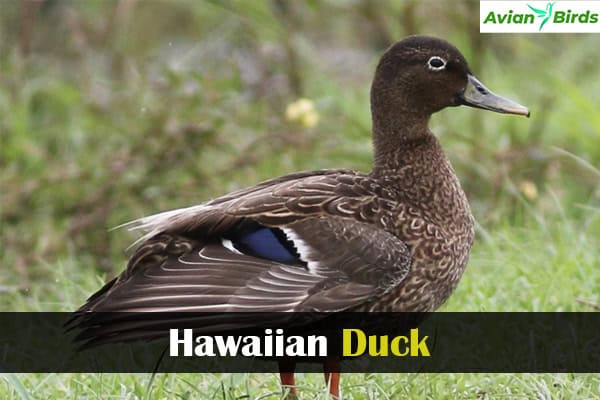
Identification and Distinct Characteristics
Hawaiian Ducks are smaller than female Mallards. Male Hawaiian Ducks don’t have the green heads of male Mallards. Instead, they have brown and gray feathers for camouflage.
Their wings show different colors, from green to blue. This makes them a joy to watch for bird enthusiasts interested in avian species.
Here are more details to help identify Hawaiian Ducks:
- Males weigh between 516.5 and 692.7 grams, and females weigh between 446.7 and 475.1 grams.
- Wingspans for males are 213 to 238 mm, females 210 to 232 mm.
- They are mostly active in the early morning and late evening.
Habitat Range: Kauai and Beyond
Hawaiian ducks’ main home is Kauai, where about 2,000 live. Small groups also live on Oahu and the Big Island. They like wetlands, ponds, and streams from 150 to 1,220 meters high.
As an endangered species, they need our help. We must protect their homes and fight threats like habitat loss and disease, which are crucial for their survival.
| Characteristic | Males | Females |
|---|---|---|
| Weight is a critical factor in assessing the health of fish and wildlife service populations. | 516.5 to 692.7 g | 446.7 to 475.1 g |
| Wingspan | 213 to 238 mm | 210 to 232 mm |
| Typical Habitat | Wetlands, riverbanks | Wetlands, riverbanks |
| Endangered Status | Yes | Yes |
Knowing about Hawaiian Ducks helps us appreciate them and their home. Every time we see them, we help protect them for the future.
Koloa Maoli
The Koloa Maoli, also known as the Hawaiian duck, has many special features. These make it stand out among waterfowl. Knowing about its looks and actions can make birdwatching more fun and meaningful.
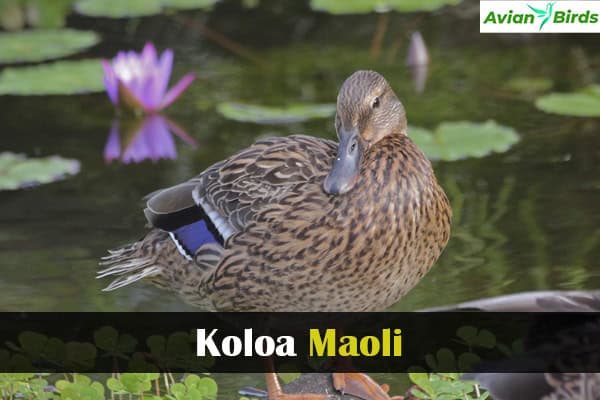
Physical Appearance
The Koloa Maoli has a mottled brown coat that helps it blend in with its wetland home. Males are 19 to 20 inches long, while females are 16 to 17 inches. They have different bill colors and feather patterns, making them hard to distinguish.
This is especially true because they can look like other ducks, like the Mallard. Hybrid traits can make spotting the real Koloa Maoli, among other Hawaiian birds, even harder.
Behavior and Nesting Habits
Koloa Maoli nests near water, hidden in thick plants to protect their eggs. They breed from December to May, laying 2 to 10 eggs. Their chicks hatch after about 30 days and can’t fly for nine weeks.
Watching how they breed helps us understand their lives and the challenges they face. Threats like hybridization with feral Mallards and habitat loss are big problems.
| Feature | Details |
|---|---|
| Size (Males) | 19-20 inches |
| Size (Females) | 16-17 inches is a common size range for many Hawaiian birds. |
| Nesting | Near water, in dense vegetation |
| Breeding Season | December to May |
| Eggs Laid | 2-10 eggs |
| Chick Flight | Unable to fly for 9 weeks |
Exploring Koloa: Hawaii’s Native Duck
The koloa, known as Anas wyvilliana, is a key part of Hawaii’s bird life. However, it’s endangered due to lost habitats and mixing with Mallards. Saving the koloa is crucial for the genetic health of native Hawaiian ducks.
Conservation Status and Endangered Species
About 2,200 Koloas live, mostly on Kauai. There are fewer on Niihau and Hawaii Island. Since the 1950s, Kauai’s Koloa numbers have grown. But it’s hard to tell pure Koloas from hybrids.
Efforts to protect their homes are key. Wetlands are vital for their survival.
Impact of Hybridization
Hybrids with Mallards are a big problem. They mix with native ducks, risking their genetic purity. Studies show many hybrids on Kauai and Hawaii Island.
This mixing makes saving the Koloa harder. It’s a big challenge for conservation.
| Parameter | Details |
|---|---|
| Estimated Koloa Population | 2,200 birds |
| Main Locations | Kauai, Niihau, Hawaii Island |
| Hybrid Presence | Common on Oahu and Maui |
| Primary Breeding Season | December to May |
| Cost of Kauai Campaign | $120,000 – $220,000 per year |
| Cost of Statewide Campaign | $175,000 – $350,000 per year |
Protecting the Koloa is vital. We need to save their homes and fight hybridization. Saving the Koloa helps Hawaii’s wetlands and all the life there.
Must Read: Ducks In Florida
Identifying the Mallard in Hawaii
Spotting a Mallard Ducks of Hawaii means knowing its special traits and changes. This duck has clear gender differences that help in birdwatching. Males have bright green heads and curly tail feathers, while females are brown, making them harder to spot.
These differences are key in knowing about Hawaiian ducks. They help us understand the impact of Mallard hybrids.

Male vs. Female Mallard Characteristics
Knowing the differences between male and female Mallards is important. Here are some main points regarding the recovery plan for Hawaiian waterbirds:
| Characteristic | Male Mallard | Female Mallard |
|---|---|---|
| Head Color | Bright green | Brown |
| Body Size | Larger | Smaller |
| Tail Feathers | Curl at the end | Straight |
| Eggs Laid | N/A | 5 to 15 eggs |
Knowing these traits helps us see how Mallard hybrids affect Hawaiian ducks. Feral Mallards in Hawaii mix with Hawaiian Ducks, making conservation harder. Studies show this mixing is a big threat to pure Hawaiian ducks.
Hybridization with Hawaiian Ducks
Mallards mixing with Koloa maoli (Hawaiian Ducks) is a big worry. Hawaii has many native birds, but only three endangered waterfowl are left. This mixing weakens the unique genes of Hawaiian ducks.
Some thought to be pure Hawaiian Ducks are actually hybrids. This makes saving these birds very urgent.
Knowing about Mallards and hybrids is key to visiting Hawaii’s wetlands. It can help local efforts to save these birds.
Diverse Duck Species in the Hawaiian Islands
The Hawaiian Islands are home to many waterbirds, including an amazing variety of ducks. These birds are key to the area’s biodiversity. They include both native and introduced species, each playing a role in the islands’ ecosystem.
Overview of Waterbirds Found in Hawaii
Ducks In Hawaii, there are many different duck species, each adding to the area’s rich biodiversity. The Hawaiian duck, or koloa maoli, is a native bird that reflects the islands’ history.
Along with the Laysan duck, these birds make up the unique bird life of the islands. The introduction of non-native species has changed the habitats. It’s important to know about both native and introduced ducks in the area.
Comparison of Endemic and Introduced Species
Endemic ducks, like the koloa maoli, are special because they evolved alone. They are very sensitive to changes in their environment. Introduced ducks, on the other hand, can adapt well but still affect native birds.
The mixing of native and non-native ducks can harm the native ones. This mixing can lead to a loss of genetic diversity among the Hawaiian bird species. Efforts to save these unique birds are crucial for Hawaii’s ecosystems.
Related: Ducks in Georgia
Behavioural Patterns in Hawaiian Ducks
Ducks of Hawaii have unique behaviours, especially during breeding and eating. Knowing these helps us protect them better.
Breeding Season and Nesting Sites
Hawaiian ducks breed from December to May. About 94% of nests start then. Females pair up more, 75%, than in other times, 48%.
Nests are often in safe, easy-to-get-to spots in wetlands. This helps them stay safe and find food.
Things like weather and food affect their breeding. Males watch for danger, while females find food for their babies on Kaua‘i, breeding peaks with other ducks.
Diet and Feeding Habits
Hawaiian ducks eat aquatic animals and plants in wetlands. They need lots of food when they’re raising their young. Females forage more to feed their babies.
They use their homes wisely to avoid fighting for food. Knowing how they eat helps us protect them and their homes.
| Behavioral Aspect | Seasonal Variation | Details |
|---|---|---|
| Nesting Initiation | Behavioural Aspect | 94% occur during this period |
| Pair Formation | Peak (Nov – Mar) | 75% of females are paired |
| Males’ Vigilance | Peak | Increased vigilance, less foraging time |
| Females’ Foraging | Peak | More time spent on foraging activities |
| Feeding Habits | Year-Round | Variety of aquatic invertebrates and plant matter |
Habitat and Conservation Efforts
Taro fields and wetlands are key for Hawaiian ducks like the Koloa. They help with food and homes. We must protect these places to keep ducks and other animals safe.
Importance of Taro Fields and Wetland Habitats
Taro fields are vital for ducks. They offer food and places to live, essential for the recovery plan for Hawaiian waterbirds. Without these areas, duck numbers drop. We need to save both natural and farmed wetlands.
Predation and Protection Strategies
Non-native predators harm Hawaiian ducks. We must stop these threats to save the Koloa. Programs to control predators and fix habitats help ducks live longer.
| Conservation Strategy | Description | Impact on Duck Populations |
|---|---|---|
| Habitat Protection is vital for maintaining the delicate balance of Hawaii’s unique ecosystems. | Preservation of wetlands and taro fields to maintain feeding and nesting areas. | Increased availability of resources supports duck survival. |
| Predator Control | Management of non-native species preying on duck populations. | Reduces mortality rates and enhances breeding success. |
| Monitoring Programs | Regular assessments of duck numbers and health across habitats. | Identifies trends and informs future conservation efforts. |
| Community Engagement | Involvement of local communities in conservation initiatives. | Raises awareness and fosters stewardship for wetland conservation. |
Notable Duck Locations in Hawaii
Looking for the best places to see ducks in Hawaii can make your birdwatching trip better. You’ll get to see both native and introduced ducks in their homes. The Hanalei National Wildlife Refuge and Kawai’ele Waterbird Sanctuary on Kauai are top picks. They have great habitats and places for fun in nature.
Best Sites for Spotting Ducks in Hawaii
Here are the top places to see ducks:
- Hanalei National Wildlife Refuge: Its wetlands are perfect for Koloa ducks, and its ponds and marshes are a favorite for birdwatchers.
- Kawai’ele Waterbird Sanctuary: It’s famous for its many birds. Here, you can see the Hawaiian Duck in a safe place. It’s great for breeding and eating.
- Koloa Habitats on Kauai: This spot has quiet streams and ponds where Koloa ducks live. It’s peaceful and perfect for finding these special birds.
- Other coastal wetlands throughout the Hawaiian islands: Look for marshes and flooded fields. They’re also key places for ducks.
Significance of National Wildlife Refuges
National wildlife refuges are key to saving Hawaii’s duck populations. They protect important places for ducks to live, eat, and rest, which is vital for endangered ducks like the Hawaiian Duck.
These refuges help keep duck homes safe. By visiting, you help show how important these places are. They help ducks thrive and fight for their survival in Hawaii.
The Role of Ducks Unlimited in Conservation
Ducks Unlimited is key in saving Hawaiian waterbirds. They work to keep habitats safe and get people involved. They fight against the loss of wetlands, which has grown by 140% lately.
Programs Focused on Hawaiian Waterbirds
In 2024, Ducks Unlimited hit a big goal by saving 1 million acres in North America. This shows their big push to save homes for many water animals, like Hawaiian ducks. They’ve saved over 18 million acres since starting, working with many to keep the environment healthy.
- They focus on fixing wetlands.
- Getting local people involved makes their work better.
- Help from a million people and groups boosts their efforts.
- Big sponsors, like Cox Enterprises, help fund their projects.
Community Involvement and Education
Ducks Unlimited really cares about teaching people about Hawaiian ducks. Also, work with communities to teach them to care for the environment. They even have groups for young people to learn about conservation in Hawaii’s unique ecosystems.
“Educating communities about the vital role of wetlands is essential for the future of our waterbirds.”
They keep working with people to teach them why wetlands are so important. Almost half of all migratory birds need these places to live, so saving wetlands is more important than ever for Hawaiian waterbirds.
Understanding Duck Hybridization
Ducks hybridization is a big problem, especially in Hawaii. Domestic Mallards mix with unique species like the Koloa Maoli. This mixing can hurt the genetic health of native ducks, making it hard to keep pure breeds alive.
Effects of Domestic Mallards on Native Populations
Domestic Mallards came to Hawaii in the 1800s. They mix with Koloa Maoli, threatening their survival. With only about 2,000 non-hybrid Koloa Maoli left, this is a big worry. Studies show Mallards and Hawaiian Ducks are mixing genes, which could lead to the loss of pure duck populations.
Research Insights on Hybrid Duck Species
Studies on hybrids are giving us important information. On Kauai, there’s a low rate of hybridization among Koloa Maoli ducks. This might be because there are more males than females. Conservation efforts are working to understand and manage hybridization. Restoring wetlands is key to helping Koloa Maoli and other native Hawaiian species.
Taking Action for Duck Conservation
Protecting Hawaiian ducks needs everyone’s help. Local groups and individuals must work together. They help spread the word about protecting these birds and their homes.
By joining hands with these groups, you can make a big difference. Your actions can help these ducks live in their natural habitats for a long time.
Role of Local Organizations and Initiatives
Local groups lead the way in protecting Hawaiian ducks. They start projects that help these birds and teach people why they matter. The Hawaiian Wildlife Fund and the National Audubon Society are two such groups.
They do important work to help Hawaiian ducks survive and grow.
How You Can Help Protect Hawaiian Ducks
There are many ways to help protect Hawaiian ducks. Here are a few:
- Volunteer with local groups to help restore their homes.
- Help spread the word about why we need to protect these birds.
- Support research and tracking of duck populations.
- Go to workshops on keeping wetlands safe for waterbirds.
- Speak up for laws that help endangered species in your area.
Your help is crucial. Working with local groups, you help these ducks thrive in their natural homes.
| Action Steps | Description |
|---|---|
| Volunteering | Join hands with local conservation groups to restore wetlands. |
| Education | Inform others about the importance of duck protection and their habitats. |
| Advocacy | Support policies that favor the conservation and preservation of indigenous bird species. |
| Community Workshops | Attend events to learn about and promote wetland conservation strategies. |
Conclusion
Ducks in Hawaii are more than just cute birds in wetlands. They include species like the Laysan duck, which is almost gone. The Koloa duck is native and very important to Hawaii’s nature.
However, these ducks face big problems. They lose their homes and mix with other birds like Mallards, making saving them urgent.
There’s good news too. Efforts to save the Koloa and Laysan ducks are working. Even though they were very close to disappearing, they’re coming back. This shows that with help, these birds can live in Hawaii again.
You can help, too, by supporting the recovery plan for Hawaiian waterbirds. Learning about Hawaii’s ducks can inspire you to support their protection. By doing this, you help keep Hawaii’s nature healthy for everyone.
Read More🐦Related Articles:
Frequently Asked Questions
Q1. What kind of ducks live in Hawaii?
The primary native duck is the Hawaiian Duck (Anas wyvilliana), also known as the Koloa.
Q2. How many Hawaiian ducks are left?
The Hawaiian Duck population is estimated to be around 1,000 to 2,000 individuals, but this number can vary.
Q3. What are some interesting facts about the Hawaiian duck?
- The Koloa is a freshwater duck and is adapted to life in Hawaii’s wetlands.
- They are primarily nocturnal and have a unique quack compared to other ducks.
- Koloa is also known to interbreed with introduced species like the Mallard, which can affect their genetic integrity.
Q4.Do ducks migrate to Hawaii?
While some ducks migrate, the Hawaiian Duck is non-migratory. However, other migratory ducks, like the Northern Pintail, may pass through Hawaii during migration.




